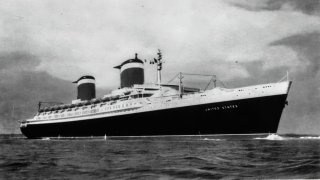SS United States Could Likely Hit 38 Knots (And Made History)
While the RMS Titanic is, by far, the most storied ocean liner in history, the most storied ocean liner in United States history is, likely, the aptly named SS United States.
While the RMS Titanic is, by far, the most storied ocean liner in history, the most storied ocean liner in United States history is, likely, the aptly named SS United States.
Built in the postwar period between 1950 and 1951, the United States Lines SS United States is the largest ocean liner ever built domestically. The SS United States is also the fastest ocean liner to ever cross the Atlantic Ocean. In fact, the SS United States still holds the Blue Riband (an unofficial accolade awarded to the ocean liner with the fastest Atlantic Crossing), which she has held since her maiden voyage in 1952.
Designing the United States
William Francis Gibbs was credited with designing the SS United States. Curiously, Gibbs began his career as an attorney but gained notoriety as a project manager in the restoration of a German ocean liner. Eventually, Gibbs and his brother would become prominent warship designers during World War II, with credits to their names including the Liberty-class and Fletcher-class. Gibbs was especially known for efficient hull designs and propulsion – which would come into play as he designed the SS United States.
The SS United States cost $79 million to construct – most of which the United States government underwrote. The vessel was built to the demanding specifications of the US Navy, which called for the vessel to be strictly compartmentalized, and to feature separate engine rooms. The reason for the stringent safety standards: the Navy wanted to be able to convert the SS United States into a warship, with minimal transition time, in the event she was needed for wartime service.
Gibbs built the SS United States to the Navy’s standards – and also to his own standards. The propulsion system, as was Gibbs’s calling card, was efficient. The vessel featured eight M-Type boilers capable of generating 310,000 pounds of steam per hour. The boilers were split into two separate engine rooms, as per the Navy’s requirements. Four were located forward, and four others were located after. Steam from the boilers turned four Westinghouse double-redaction geared turbines. Each turbine was capable of producing 60,000 horsepower, for a combined 240,000 horsepower. The turbines led to four shafts, which in turn led to four propellers. The two outermost propellers had four blades while the innermost two had five blades. The unorthodox blade configuration helped to reduce cavitation and vibration and allowed the SS United States to achieve her record-breaking speeds.
Breaking Records for SS United States
The top speed of the SS United States is still disputed, after being withheld as sensitive military information. Different sources have published different top speeds, ranging from between thirty-five knots and forty-three knots. The true speed is believed to be about thirty-eight knots per hour.
The vessel’s speed was put to good use on her maiden voyage, in 1952, when the SS United States crossed the Atlantic Ocean, from New York, New York to Cornwall, United Kingdom in just here days, ten hours, and forty minutes. The run was fast enough to earn the Blue Riband, which has not been relinquished in the seventy years since. On her return voyage, the SS United States set a record for the fastest westbound voyage, with a run of three days, twelve hours, and twelve minutes.
About the Author: Harrison Kass
Harrison Kass is a defense and national security writer with over 1,000 total pieces on issues involving global affairs. An attorney, pilot, guitarist, and minor pro hockey player, Harrison joined the US Air Force as a Pilot Trainee but was medically discharged. Harrison holds a BA from Lake Forest College, a JD from the University of Oregon, and an MA from New York University. Harrison listens to Dokken.
Image Credit: Creative Commons and/or Shutterstock.


